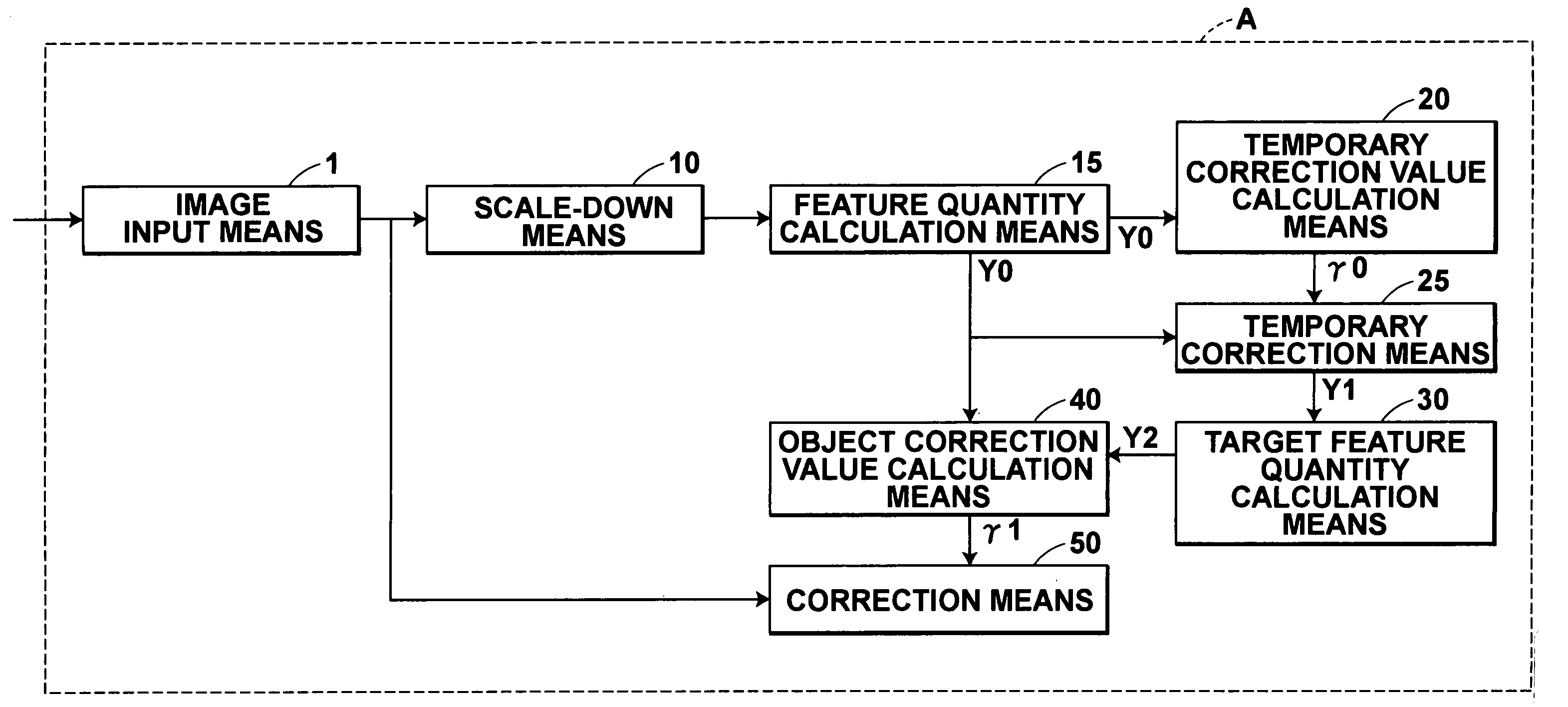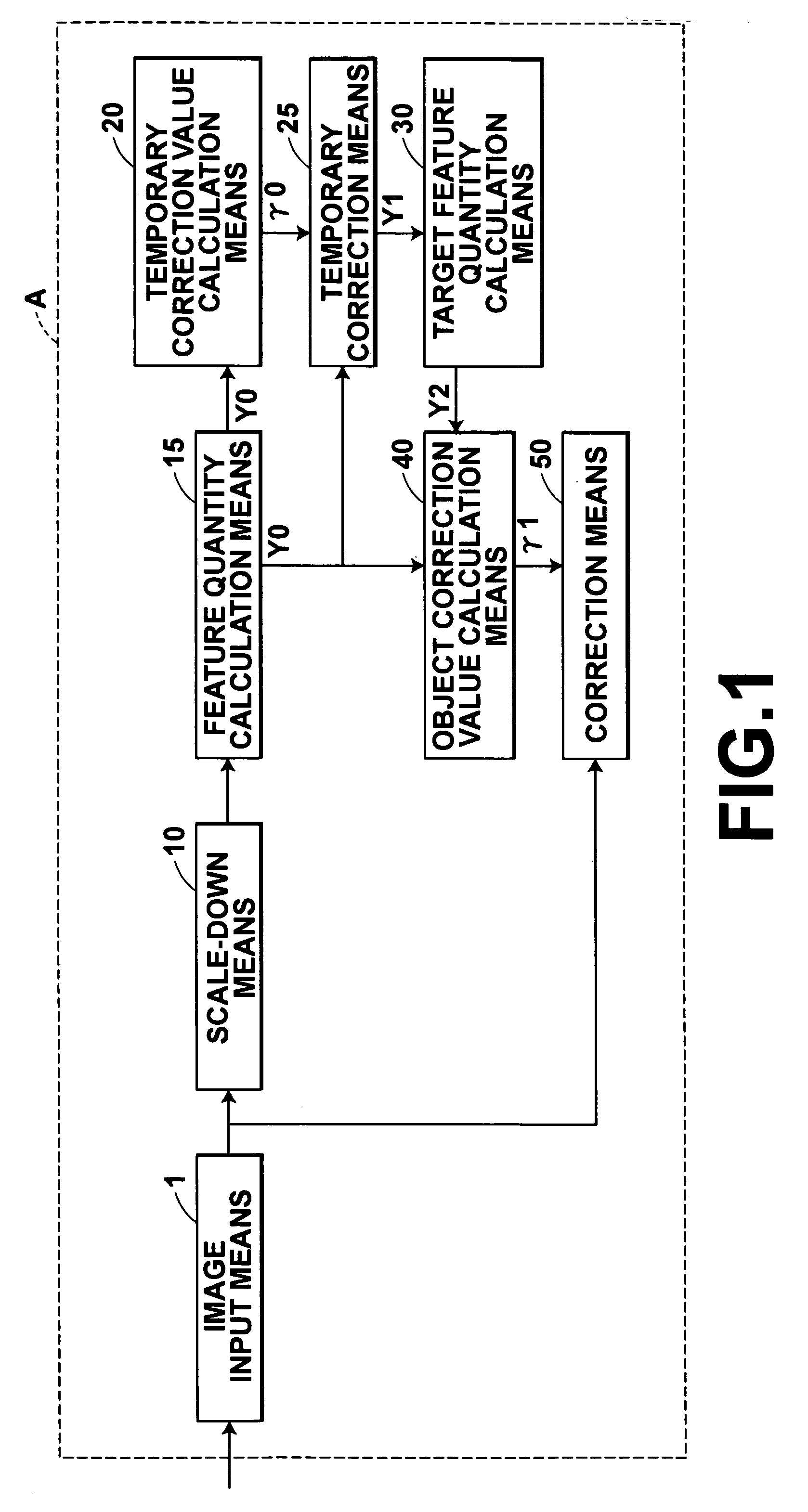Method, system, and program for correcting the image quality of a moving image
- Summary
- Abstract
- Description
- Claims
- Application Information
AI Technical Summary
Benefits of technology
Problems solved by technology
Method used
Image
Examples
first embodiment
[0074] As shown in FIG. 1, the image processing system A of the first embodiment has eight major parts: (1) image input means 1 for acquiring a plurality of picture frames constituting a moving image; (2) scale-down means 10 for scaling down a picture frame and obtaining a thumbnail frame image; (3) feature quantity calculation means 15 for calculating a feature quantity of a thumbnail frame image, (4) temporary correction value calculation means 20 for calculating a temporary correction value using the feature quantity calculated by the feature quantity calculation means 15; (5) temporary correction means 25 for calculating a feature quantity of a temporarily corrected thumbnail frame image obtained by correcting a thumbnail frame image, using the temporary correction value calculated by the temporary correction value calculation means 20; (6) target feature quantity calculation means 30 for calculating a target feature quantity of each thumbnail frame image using the feature quant...
second embodiment
[0103] In the image processing system B, as shown in the figure, a picture frame obtained by the image input means 101 is scaled down by the scale-down means 110 and is obtained as a thumbnail frame image (S110 and S112). The feature quantity calculation means 115 calculates a feature quantity Y0 from each picture frame (S114). The reference picture frame selection means 118 first determines reference picture frames from the picture frames of the moving image. In the second embodiment, the reference picture frame selection means 118 selects reference picture frames by calculating the similarity, in the temporal direction, between picture frames and determining the interval between reference picture frames. The similarity can employ the correlation between picture frames. For example, the similarity can be made higher as the correlation becomes greater. If the determined interval between reference picture frames is n (where n is an integer ≧2), the first picture frame, the (n+1)st pi...
third embodiment
[0114] As shown in FIG. 7, the image processing system C of the third embodiment has five major parts: (1) image input means 201 for acquiring a plurality of picture frames constituting a moving image; (2) scale-down means 210 for scaling down a picture frame and obtaining a thumbnail frame image; (3) temporary correction value calculation means 220 for calculating a temporary correction value from the thumbnail frame image; (4) object correction value calculation means 240 for calculating an object correction value for a picture frame based on the temporary correction value calculated by the temporary correction value calculation means 220; and (5) correction means 250 for obtaining a corrected moving image by correcting each picture frame, using the object correction value calculated by the object correction value calculation means 240.
[0115] The temporary correction value calculation means 220 calculates a temporary correction value as follows. The temporary correction value calc...
PUM
 Login to View More
Login to View More Abstract
Description
Claims
Application Information
 Login to View More
Login to View More - R&D
- Intellectual Property
- Life Sciences
- Materials
- Tech Scout
- Unparalleled Data Quality
- Higher Quality Content
- 60% Fewer Hallucinations
Browse by: Latest US Patents, China's latest patents, Technical Efficacy Thesaurus, Application Domain, Technology Topic, Popular Technical Reports.
© 2025 PatSnap. All rights reserved.Legal|Privacy policy|Modern Slavery Act Transparency Statement|Sitemap|About US| Contact US: help@patsnap.com



